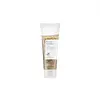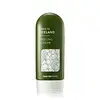What's inside
What's inside
 Key Ingredients
Key Ingredients

 Benefits
Benefits

 Concerns
Concerns

 Ingredients Side-by-side
Ingredients Side-by-side

Water
Skin ConditioningDisodium Cocoamphodiacetate
CleansingGlycerin
HumectantCoco-Betaine
CleansingDisodium Cocoyl Glutamate
CleansingAcrylates Copolymer
Sodium Chloride
Masking1,2-Hexanediol
Skin ConditioningCentella Asiatica Flower/Leaf/Stem Extract
Skin ConditioningCentella Asiatica Extract
CleansingFicus Carica Fruit Extract
HumectantSolanum Melongena Fruit Extract
Skin ConditioningLonicera Japonica Flower Extract
Skin ConditioningForsythia Suspensa Fruit Extract
AntioxidantAngelica Gigas Root Extract
Skin ConditioningCnidium Officinale Root Extract
Skin ConditioningGardenia Jasminoides Fruit Extract
Cosmetic ColorantCoptis Japonica Root Extract
Skin ConditioningGlycyrrhiza Uralensis Root Extract
Skin ConditioningPogostemon Cablin Leaf Oil
MaskingJuniperus Virginiana Oil
MaskingArtemisia Vulgaris Oil
PerfumingHydrogenated Lecithin
EmulsifyingMentha Arvensis Leaf Oil
MaskingCitric Acid
BufferingPolyglyceryl-10 Laurate
Skin ConditioningBeta-Glucan
Skin ConditioningTromethamine
BufferingHexylene Glycol
EmulsifyingSodium Phytate
Panthenol
Skin ConditioningCeramide NP
Skin ConditioningEthylhexylglycerin
Skin ConditioningHydroxyacetophenone
AntioxidantWater, Disodium Cocoamphodiacetate, Glycerin, Coco-Betaine, Disodium Cocoyl Glutamate, Acrylates Copolymer, Sodium Chloride, 1,2-Hexanediol, Centella Asiatica Flower/Leaf/Stem Extract, Centella Asiatica Extract, Ficus Carica Fruit Extract, Solanum Melongena Fruit Extract, Lonicera Japonica Flower Extract, Forsythia Suspensa Fruit Extract, Angelica Gigas Root Extract, Cnidium Officinale Root Extract, Gardenia Jasminoides Fruit Extract, Coptis Japonica Root Extract, Glycyrrhiza Uralensis Root Extract, Pogostemon Cablin Leaf Oil, Juniperus Virginiana Oil, Artemisia Vulgaris Oil, Hydrogenated Lecithin, Mentha Arvensis Leaf Oil, Citric Acid, Polyglyceryl-10 Laurate, Beta-Glucan, Tromethamine, Hexylene Glycol, Sodium Phytate, Panthenol, Ceramide NP, Ethylhexylglycerin, Hydroxyacetophenone
Cetraria Islandica Extract
CleansingCellulose
Absorbent1,2-Hexanediol
Skin ConditioningCentella Asiatica Extract
CleansingFicus Carica Fruit Extract
HumectantAlgae Extract
EmollientEclipta Prostrata Leaf Extract
Skin ConditioningCitrus Limon Fruit Extract
MaskingHamamelis Virginiana Extract
AntiseborrhoeicRubus Chamaemorus Seed Extract
Skin ConditioningCarica Papaya Fruit Extract
Skin ConditioningHydrogenated Lecithin
EmulsifyingSodium Hyaluronate
HumectantPolyglyceryl-10 Laurate
Skin ConditioningWater
Skin ConditioningCarbomer
Emulsion StabilisingTromethamine
BufferingGlycerin
HumectantDipropylene Glycol
HumectantFructooligosaccharides
HumectantLecithin
EmollientBeta-Glucan
Skin ConditioningHydrolyzed Hyaluronic Acid
HumectantCeramide NP
Skin ConditioningSodium Acetylated Hyaluronate
HumectantParfum
MaskingPhenoxyethanol
PreservativeEthylhexylglycerin
Skin ConditioningCetraria Islandica Extract, Cellulose, 1,2-Hexanediol, Centella Asiatica Extract, Ficus Carica Fruit Extract, Algae Extract, Eclipta Prostrata Leaf Extract, Citrus Limon Fruit Extract, Hamamelis Virginiana Extract, Rubus Chamaemorus Seed Extract, Carica Papaya Fruit Extract, Hydrogenated Lecithin, Sodium Hyaluronate, Polyglyceryl-10 Laurate, Water, Carbomer, Tromethamine, Glycerin, Dipropylene Glycol, Fructooligosaccharides, Lecithin, Beta-Glucan, Hydrolyzed Hyaluronic Acid, Ceramide NP, Sodium Acetylated Hyaluronate, Parfum, Phenoxyethanol, Ethylhexylglycerin
 Reviews
Reviews

Ingredients Explained
These ingredients are found in both products.
Ingredients higher up in an ingredient list are typically present in a larger amount.
1,2-Hexanediol is a synthetic liquid and another multi-functional powerhouse.
It is a:
- Humectant, drawing moisture into the skin
- Emollient, helping to soften skin
- Solvent, dispersing and stabilizing formulas
- Preservative booster, enhancing the antimicrobial activity of other preservatives
Beta-Glucan is a polysaccharide. It can be derived from the cell walls of seaweed, oats, yeast, and fungi. It hydrates the skin and helps boost your skin's natural barrier.
As an antioxidant, beta-glucan helps fight free-radicals. Free-radicals are molecules that may damage your skin cells, such as pollution.
Studies show this ingredient may be an effective wrinkle reducer as it can deeply penetrate into skin. It has also been show to help with wound healing.
Learn more about Beta-GlucanCentella Asiatica Extract (Centella) is derived from an herb native to Southeast Asia. It is famous for its anti-inflammatory and soothing properties.
Centella is rich in antioxidants and amino acids, such as Madecassic Acid and Asiaticoside.
Studies show the compounds in centella help with:
The combination of all these properties makes centella effective at soothing, hydrating, and protecting the skin.
Other great components of centella include Vitamin A, vitamin C, several B vitamins, and Asiatic Acid.
Fun fact: Centella has been used as a medicine and in food for many centuries. As a medicine, it is used to treat burns, scratches, and wounds.
Learn more about Centella Asiatica ExtractCeramide NP is a type of ceramide and formally known as ceramide 3.
Ceramides are intercellular lipids naturally found in our skin that bonds dead skin cells together to create a barrier. They are known for their ability to hold water and thus are a great ingredient for dry skin.
Ceramides are an important building block for our skin barrier. A stronger barrier helps the skin look more firm and hydrated. By bolstering the skin ceramides act as a barrier against irritating ingredients. This can help with inflammation as well.
If you would like to eat ceramides, sweet potatoes contain a small amount.
Read more about other common types of ceramides here:
Ceramide AP
Ceramide EOP
Ethylhexylglycerin (we can't pronounce this either) is commonly used as a preservative and skin softener. It is derived from glyceryl.
You might see Ethylhexylglycerin often paired with other preservatives such as phenoxyethanol. Ethylhexylglycerin has been found to increase the effectiveness of these other preservatives.
Ficus Carica Fruit Extract comes from the fruit known as the fig. Figs are rich in antioxidants and helps hydrate the skin.
Figs also contain fatty acids and Vitamins A, B1, and B2.
As a humectant, figs are able to draw moisture from the air to your skin. This helps keep your skin hydrated.
Learn more about Ficus Carica Fruit ExtractGlycerin is already naturally found in your skin. It helps moisturize and protect your skin.
A study from 2016 found glycerin to be more effective as a humectant than AHAs and hyaluronic acid.
As a humectant, it helps the skin stay hydrated by pulling moisture to your skin. The low molecular weight of glycerin allows it to pull moisture into the deeper layers of your skin.
Hydrated skin improves your skin barrier; Your skin barrier helps protect against irritants and bacteria.
Glycerin has also been found to have antimicrobial and antiviral properties. Due to these properties, glycerin is often used in wound and burn treatments.
In cosmetics, glycerin is usually derived from plants such as soybean or palm. However, it can also be sourced from animals, such as tallow or animal fat.
This ingredient is organic, colorless, odorless, and non-toxic.
Glycerin is the name for this ingredient in American English. British English uses Glycerol/Glycerine.
Learn more about GlycerinHydrogenated Lecithin is created from the hydrogenation of lecithin (a group of phospholipids). Hydrogenation is a chemical reaction between hydrogen and another element.
This ingredient is an emollient and emulsifier. As an emollient, it helps soften skin by trapping moisture within. As an emulsifier, it prevents oil and water ingredients from separating.
Polyglyceryl-10 Laurate is an ester of lauric acid and Polyglycerin-10.
Polyglyceryl-10 Laurate is a cleansing agent and emulsifier. It helps gather dirt, oil, and other pollutants to be rinsed away. As an emulsifier, it helps prevent ingredients from separating, such as oil and water.
Polyglyceryl-10 Laurate may not be fungal acne safe.
Learn more about Polyglyceryl-10 LaurateTromethamine helps balance the pH and improve the texture of a product. It is synthetically created.
As an emulsifier, Tromethamine prevents oil and water ingredients from separating. This helps stabilize the product and elongate a product's shelf life. Tromethamine also makes a product thicker.
Tromethamine helps balance the pH level of a product. Normal pH level of skin is slightly acidic (~4.75-5.5). The acidity of our skin is maintained by our glands and skin biome. Being slightly acidic allows our skin to create an "acid mantle". This acid mantle is a thin barrier that protects our skin from bacteria and contaminants.
Oral Tromethanmine is an anti-inflammatory drug but plays the role of masking, adding fragrance, and/or balancing pH in skincare.
1,3-Propanediol, 2-amino-2-(hydroxymethyl)-
Learn more about TromethamineWater. It's the most common cosmetic ingredient of all. You'll usually see it at the top of ingredient lists, meaning that it makes up the largest part of the product.
So why is it so popular? Water most often acts as a solvent - this means that it helps dissolve other ingredients into the formulation.
You'll also recognize water as that liquid we all need to stay alive. If you see this, drink a glass of water. Stay hydrated!
Learn more about Water